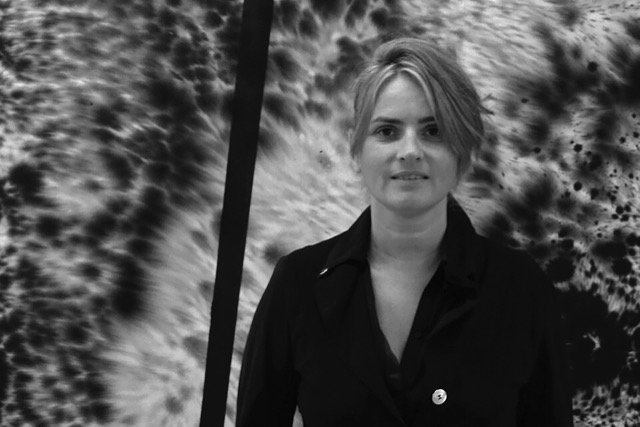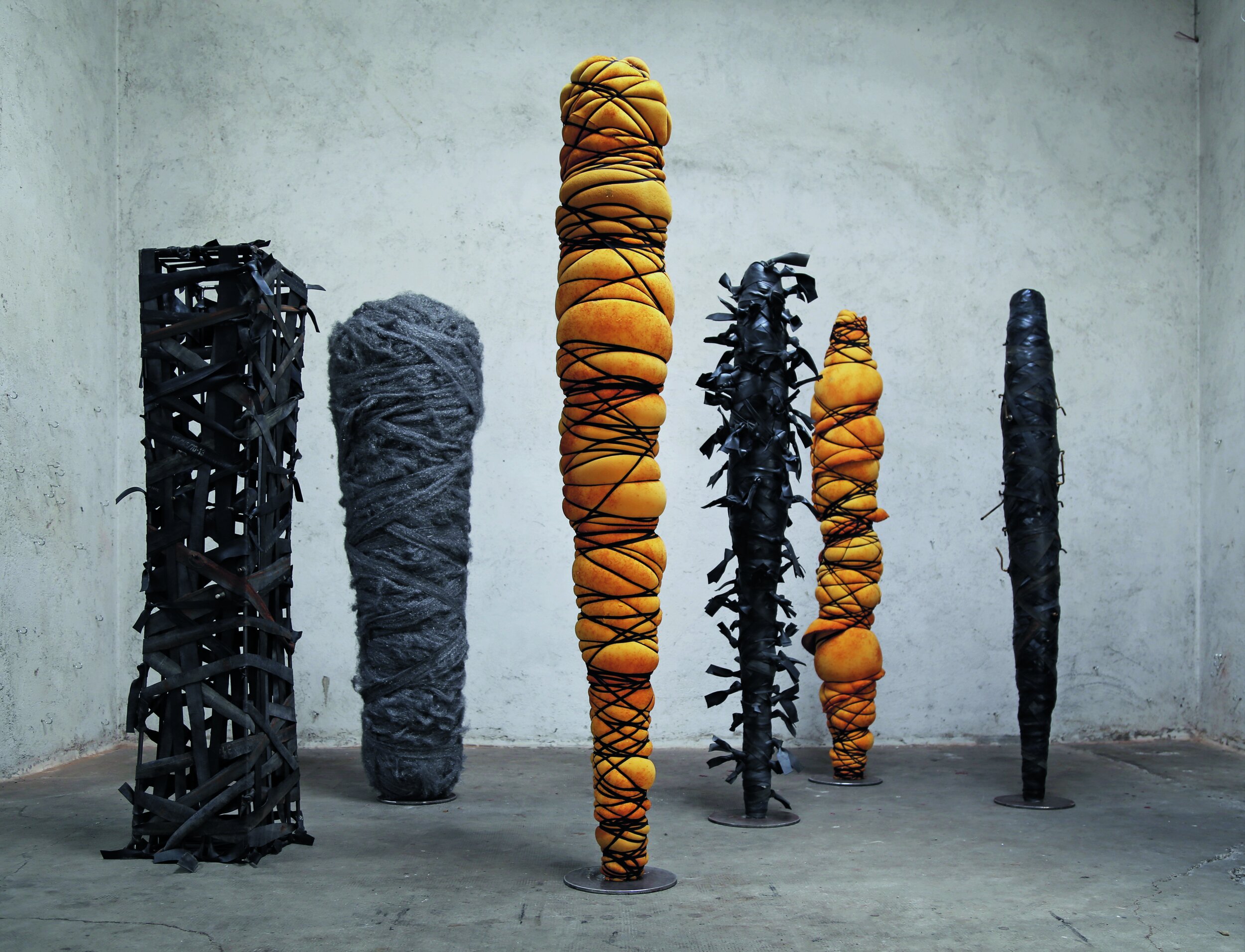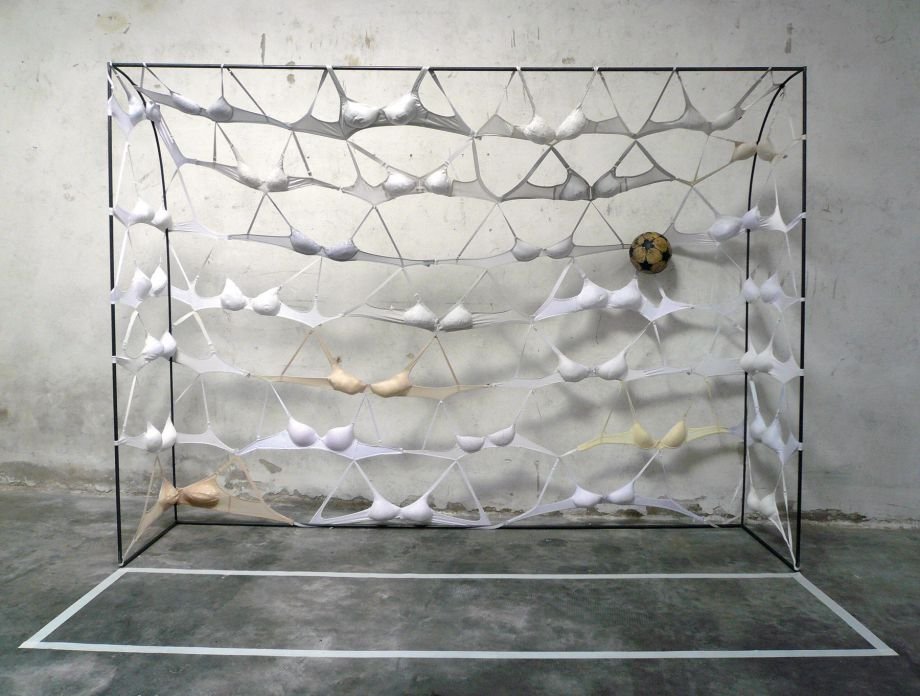JULIA BORNEFELD,
artist
July, 1st 2022
ENG
Julia Bornefeld was born in Kiel, Germany, in 1963. She studied painting at the Fachhochschule für Gestaltung in her hometown between 1984 and 1989, simultaneously attending courses at the Academy of Fine Arts in Venice held by Emilio Vedova, and at the Akademija Likovna Umjetnost in Ljubljana.
As a multimedia artist, since the 1990s Julia Bornefeld has developed a broad and diversified expressive language that crosses painting, sculpture, collage, video, photography, installation and performance, united by the energetic tension that the artist infuses into each of her works, working both with primary elements, materials and organic processes, such as fire, rust and coal, and with humble objects and materials that preserve the memory of lived experiences. The main themes of her research concern history, power dynamics, the body in the relationship between man and woman, cyclical processes of creation and destruction, and the ambivalence in social relationships.
She lives and works between Berlin and Bruneck (BZ).
ITA
Julia Bornefeld è nata a Kiel, in Germania, nel 1963. Ha studiato pittura presso la Fachhochschule für Gestaltung nella sua città natale tra il 1984 e il 1989, frequentando contemporaneamente corsi presso l’Accademia di Belle Arti a Venezia tenuti da Emilio Vedova, e presso l’Akademija Likovna Umjetnost a Lubiana.
Artista multimediale, a partire dagli anni ’90 Julia Bornefeld ha sviluppato un linguaggio espressivo ampio e diversificato che attraversa pittura, scultura, collage, video, fotografia, installazione e performance, accomunato dalla tensione energica che l’artista infonde in ogni sua opera, lavorando sia con elementi primari, materiali e processi organici, come il fuoco, la ruggine, il carbone, sia con oggetti e materiali umili, che conservano la memoria della vista vissuta.
I temi principali della sua ricerca riguardano la storia, le dinamiche del potere, il corpo nella relazione tra uomo e donna, la ciclicità nei processi di creazione e distruzione, e l’ambivalenza nelle relazioni sociali.
Vive e lavora tra Berlino e Brunico (BZ).
ENG
LZ: Lightness and force of gravity, attraction and repulsion, expansion and concentration, are some of the pairs of opposites that characterize your sculptural language, developed between the 1990s and the early 2000s. These are large objects, elements that recall anatomical parts of the human or animal body, envelopes often similar to the shape of an egg, or a funnel, suspended in a fluctuating space between the oniric and the real. How has your sculptural research continued over the years?
JB: Between 2010 and 2022, the element of fire entered my work. In performance-like actions, a woman jumped through a burning fire hoop, and a table at which thirteen people gathered for a supper on an icy lake was in flames. The resulting photo installation The Burning Supper was exhibited in Innsbruck Cathedral and in the Kunstkirche St. Petri in Lübeck, among other places. The word Mama, bent in the shape of a child's handwriting from steel rods and wrapped in straw, burned symbolically for the primordial connection between mother and child. In many cultures, the transitions between life and death and the associated processes of detachment are ritualized by the element of fire.
In recent years, I have created light and sound installations. The installation Ariadne's Asteroid Slingshot is a "sky machine" rotating on a motor, developed for one of the disused dark arsenals of Franzensfeste for the Provincial Exhibition “Labyrinth: Freedom", South Tyrol 2009. The rotating light object is enveloped by "spherical sounds". The cello, used as the central instrument, spins an acoustic Ariadne thread, the "red thread "into the seventh heaven of Ariadne" and thus an actual "red thread" also runs through my work.
The work Porifera, a 500 cm x 250 cm x 250 cm submarine-like structure made of iron rods and covered with material similar to a sea sponge, became a light installation in reference to the sponges of the oceans that communicate through light. Sponges are the oldest multicellular animals in terms of developmental biology; they are able to transmit light with the help of amorphous silicate structures.
For many years I knotted objects made of black rope and rubber. Knots is an installation consisting of a 100-meter-long black snake-like cord with many irregularly arranged knots. Melas and Paradigma are series of works showing rubber cords wound partly vertically and horizontally over steel frames. The cords have many small knots and form a weave of intertwined right-angled lines that connect and overlap. Tying a knot gives concrete physical form to an abstract idea, intention or thought. In many world religions, the knot was originally used as a prayer chain. Like the labyrinth, the knot is one of the ambiguous symbols. Knots embody continuity. In Buddhism, knot symbols stand for connection and eternity.
IT
LZ: Leggerezza e forza di gravità, attrazione e repulsione, espansione e concentrazione, sono alcune delle coppie di opposti che caratterizzano il tuo linguaggio plastico, sviluppato tra gli anni ’90 e i primi anni 2000. Si tratta di oggetti di grandi dimensioni, elementi che richiamano parti anatomiche del corpo umano o animale, invlocucri spesso tendenti alla forma dell’uovo, o dell’imbuto, sospese in uno spazio fluttuante tra l’onirico e il reale. Come è proseguita negli anni la tua ricerca scultorea?
JB: Tra il 2010 e il 2022, l'elemento del fuoco è entrato nel mio lavoro. Nel corso di azioni simili a performance una donna ha saltato attraverso un cerchio infuocato, un tavolo attorno cui tredici persone si erano riunite per una cena su un lago ghiacciato, era in fiamme. L'installazione fotografica risultante, The Burning Supper, è stata esposta, tra l'altro, nella cattedrale di Innsbruck e nella Kunstkirche St. Petri di Lubecca. La parola Mama, modellata in forma di scrittura infantile attraverso aste di acciaio avvolte nella paglia, bruciava alludendo simbolicamente al legame primordiale tra madre e figlio. In molte culture le transizioni tra la vita e la morte e i relativi processi di distacco vengono ritualizzati attraverso l’elemento del fuoco.
Negli ultimi anni ho creato installazioni luminose e sonore. L'installazione Ariadne's Asteroid Slingshot è una "macchina del cielo" che ruota su un motore, sviluppata per uno degli arsenali bui dismessi di Franzensfeste per la Mostra Provinciale “Labirinto: Libertà", Alto Adige 2009. L'oggetto luminoso rotante è avvolto da "suoni sferici". Il violoncello, utilizzato come strumento centrale, tesse un filo di Arianna acustico, il "filo rosso" nel settimo cielo di Arianna, e quindi un vero e proprio "filo rosso" attraversa anche la mia opera.
L'opera Porifera, con una struttura simile ad un sottomarino di 500 cm x 250 cm x 250 cm realizzata con tondini di ferro e ricoperta di materiale simile alla spugna marina, è diventata un'installazione luminosa in riferimento alle spugne degli oceani che comunicano attraverso la luce. Le spugne sono gli animali multicellulari più antichi in termini di biologia dello sviluppo; sono in grado di trasmettere la luce con l'aiuto di strutture di silicato amorfo.
Per molti anni ho annodato oggetti in corda nera e gomma. Knots è un’installazione costituita da una corda nera a forma di serpente lunga 100 metri con molti nodi disposti irregolarmente. Melas e Paradigma sono una serie di opere che mostrano corde di gomma avvolte in parte verticalmente e in parte orizzontalmente su telai di acciaio. Le corde hanno molti piccoli nodi e formano un intreccio di linee ortogonali che si collegano e si sovrappongono. Fare un nodo dà forma fisica e concreta a un'idea, un'intenzione o un pensiero astratto. In molte religioni del mondo il nodo era originariamente utilizzato come catena di preghiera. Come il labirinto, il nodo è uno dei simboli più ambigui. I nodi incarnano la continuità. Nel buddismo, i simboli dei nodi sono sinonimo di connessione ed eternità.
Untitled, steel, muslin, coal dust, 250 x 300 x 300 cm, 1995. Exhibition by Julia Bornefeld and Louise Evans, L’H du Siège Centre d’art contemporain, Valencienne.
Pomp, Derma, Omno, Derma, Pneu, 2016. View of the studio.
Knots, foam, nylon fabric, dimensions variable, 2015. Somniflos exhibition, Galerie Elisabeth & Klaus Thoman, Insbruck, 2015
Porifera, steel, led, expanded fibre, electronic circuit sound system 500 x 250 x 250 cm, 2018. Grenzgange exhibition, Fortress Fortezza (BZ), 2018. Sound by Thomas Meyer.
Paradigma XVII, steel, rubber, 40 x 30 x 5 cm, 2016.
Oxidation IV, plaster, rust, graphite, 76 x 56 cm, 2020.
Pads V, ink on canvas, 160 x 120 cm, 2015.
ENG
LZ: You are an 'alchemist' of materials, which you sometimes make react directly on the paper or canvas support. You have worked with coal dust, feathers, rust, and rubber, to name but a few. What has been and still is your approach to textiles?
JB: Between 1990 and 2010 I worked with coal again and again. The surfaces of my paintings and objects consisted of finely ground coal dust. Coal was formed over millions of years from dead plants that were exposed to high pressure and temperatures in deep layers of the earth, which led to the process of carbonization. Coal is used for heating and for me it has a very energetic aura.
I sewed objects from nettle fabric and stretched them over iron frames, the canvases were also made of nettle. Furthermore, I worked with bitumen, also a product of petroleum extraction.
Oxidation processes have been reproducing organic development processes directly on my canvases and on the surfaces of my objects for about 3 years. The efflorescence of rust is captured on the canvases.
Textile materials are my image carriers, from them I create sometimes voluminous objects, which on one hand appear heavy and large-sized, on the other hand, are very light and fragile and are constructed in the form of tent systems.
I have always created works and used "humble materials" in which the memory of lived life is preserved.
IT
LZ: Sei un “alchimista” dei materiali, che talvolta fai reagire direttamente sul supporto della carta o della tela. Hai lavorato con polvere di carbone, piume, ruggine, gomma, per citarne solo alcuni. Qual è stato e qual è tutt’ora il tuo approccio alla materia tessile?
JB: Tra il 1990 e il 2010 ho lavorato più volte con il carbone. Le superfici dei miei dipinti e degli oggetti erano costituite da polvere di carbone finemente macinata. Il carbone si è formato nel corso di milioni di anni da piante morte esposte ad alte pressioni e temperature in strati profondi della terra, che hanno portato al processo di carbonizzazione. Il carbone viene utilizzato per il riscaldamento e per me ha un'aura molto energetica.
Ho cucito oggetti con un tessuto di ortica e li ho disposti su telai di ferro; anche le tele erano fatte di ortica. Inoltre, ho lavorato con il bitume, anch'esso un prodotto derivato dalla raffinazione del petrolio.
Da circa 3 anni processi di ossidazione producono processi di sviluppo organico direttamente sulle mie tele e sulle superfici dei miei oggetti. L'efflorescenza della ruggine viene catturata sulle tele.
I materiali tessili sono i miei portatori di immagine e dal materiale tessile creo oggetti talvolta voluminosi, che da un lato appaiono pesanti e di grandi dimensioni, dall'altro sono molto leggeri e fragili e sono costruiti sotto forma di sistemi di tende.
Ho sempre creato opere e utilizzato "materiali umili" in cui si conserva la memoria della vita vissuta.
ENG
LZ: Another pair of opposites that recurs in your work is that of the masculine and feminine, from which the theme of the construction of the sexes derives, addressed through strategies of estrangement and irony. What is your point of view on this theme?
JB: Between 2005 and 2010 the human body, the relationship between woman and man, play a role in my objects and paintings. Social values as well as women themselves have always modeled the female body, disregarding their own pain threshold.
Women's skirts turn on merry-go-rounds, men's trousers on flagpoles in the wind. Snake-like legs sewn from nylon fabrics grow into oversized knots. A man's suit suspended in a steel rod reminiscent of a woman's handbag challenges patriarchal dominance. A football goal in which the ball is suspended from a net made of women's bras alludes to relations between men and women with the viewer's otherwise familiar gaze.
My objects are conceived in such a way that they can initially be experienced physically, as a physical presence.
IT
LZ: Un’altra coppia di opposti che ricorre nel tuo lavoro è quella del maschile e femminile, da cui poi deriva il tema della costruzione dei sessi, affrontato attraverso strategie di straniamento e ironia. Qual è il tuo punto di vista su questa tematica?
JB: Tra il 2005 e il 2010 il corpo umano, la relazione tra donna e uomo, giocano un ruolo importante nei miei oggetti e dipinti. I valori sociali e le donne stesse hanno sempre modellato il corpo femminile, ignorando la propria soglia del dolore.
Le gonne delle donne girano su giostre, i pantaloni degli uomini su pennoni al vento. Le zampe a forma di serpente cucite con tessuti di nylon crescono fino a formare nodi di dimensioni eccessive. Un abito da uomo sospeso in un'asta d'acciaio che ricorda una borsa da donna sfida il dominio patriarcale. Una porta da calcio in cui la palla è sospesa da una rete fatta di reggiseni femminili allude alle relazioni tra uomini e donne con lo sguardo altrimenti familiare dello spettatore.
I miei oggetti sono concepiti in modo tale da poter essere inizialmente vissuti fisicamente, come una presenza fisica.
Haut-nah, ladies handbag, steel, men's suit, shoes, filling wool, nylon fabric, 180 x 220 x 72 cm, 2005. Courtesy Galerie Elisabeth & Klaus Thoman, Innsbruck Wien, Sammlung Tiroler Landesmuseum Ferdinandeum, Innsbruck.
Eigentor, steel, bras, filling wool, football, 220 x 300 x 150 cm, 2009. Courtesy Antonella Cattani, Contemporary Art Bolzano, private collection.











